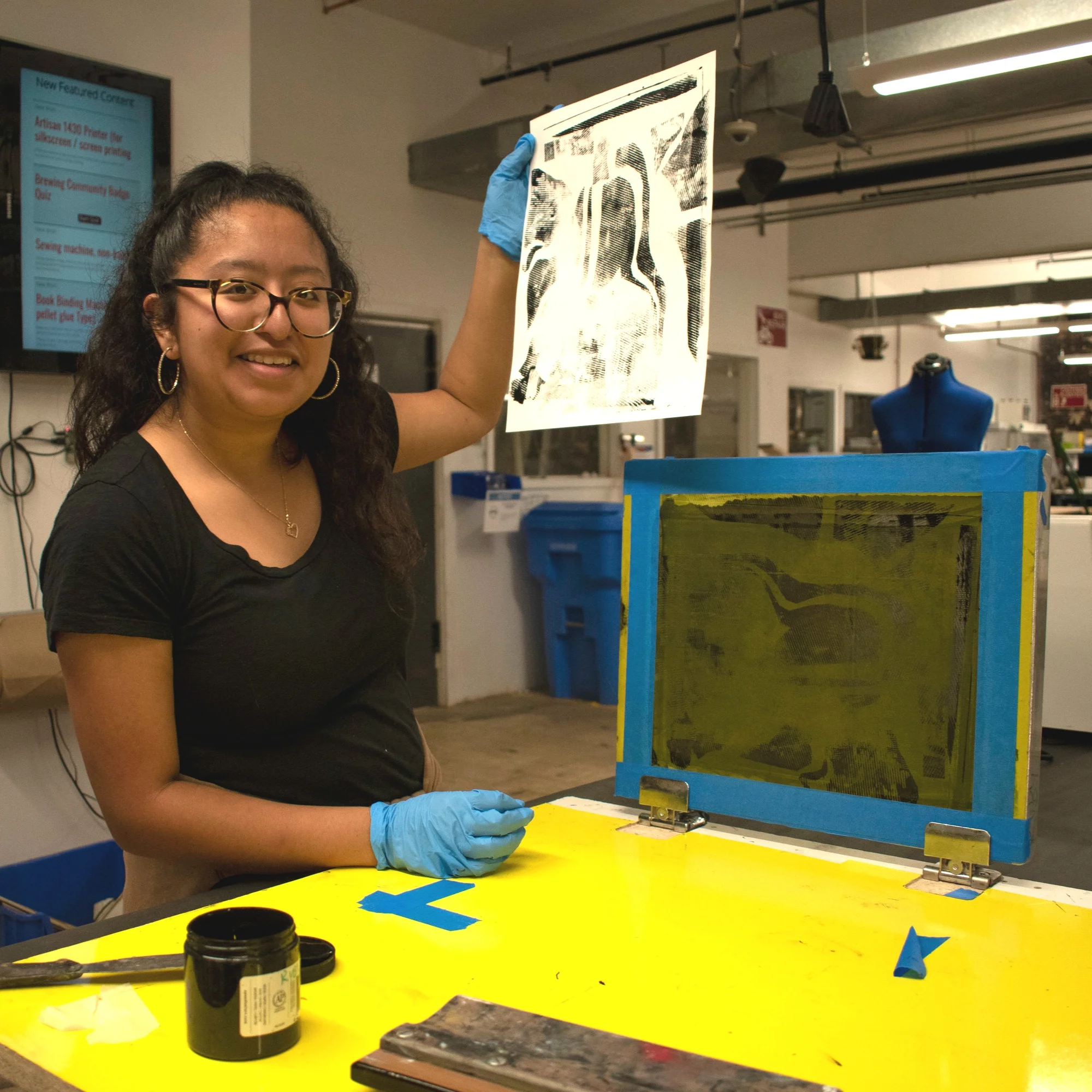The Million-Petaled Flower of Being Here | Edgar Serrano
The Million-Petaled Flower of Being Here | Edgar Serrano
Edgar Serrano in his Erector Square Studio. Photo: J. Gleisner.
A small boy looks up at a television screen inside a detention center at the Mexican-American border. He’s watching Casper the Friendly Ghost, a cartoon about a ghost trapped between two realities. The child is surrounded by others, yet he seems alone and unsure of his surroundings. Inside his Erector Square studio, Edgar Serrano described feeling struck by this image in a New York Times article last year. He remembers looking across the room at his own son, who was around the same age. Comparing these two children—one safe and the other displaced with an uncertain future—triggered introspection for Serrano, whose parents entered this country illegally from Mexico. “If it weren’t for my son, I don’t know if reading about the detention centers would have been as visceral and profound of an experience,” explained Serrano.
Serrano’s parents—now legal citizens—emigrated to the United States in the late1970s to seek employment opportunities. Serrano was born here, but his parents sent him to live with his grandmother in a small town in Zacatecas for the first five years of his life. He later returned to Chicago to start elementary school. During the first few years of his life in Mexico, Serrano had to learn to be independent and rely on his imagination to engage with his environment. “My parents didn’t have an affinity for high art or culture, so the images that populated my childhood were reproductions and cartoons,” stated Serrano. From an early age, he made drawings based on cartoons characters and images found on the cheaply mass-produced reproductions that orbited him. These democratic images created an entry point for his interest in art.
Edgar Serrano, The Hermit and the Raven (2018). 44 x 60 inches; Oil on canvas. Image courtesy of the artist.
After Serrano graduated high school, he was still drawing regularly, but he wasn’t aware that he could study art or pursue a career within the field. Looking to advance his interest in art, he called 4-1-1 to ask for art-related leads. The telephone operator directed him to a local art store, where he applied for a job. After about a year, Serrano was transferred to a satellite location inside the School of the Art Institute of Chicago. With the encouragement of a professor who had seen his drawings inside the store, Serrano applied to art school.
Talented from a young age, Serrano received The Presidential Merit Scholarship, but he felt like an outsider among his peers. For an art history assignment, Serrano bought postcards from the gift store, in lieu of studying and writing about them inside the museum, where he felt out of place. At SAIC, he swapped his MAD Magazines for ArtForum, Frieze, and other publications that were recommended to him by a classmate. The same friend also later encouraged him to apply to MFA painting programs.
Serrano was working as an art handler when he received his acceptance letter from Yale University’s School of Art. He felt reluctant to take out more student loans, but when he discussed his reservations with the head of the painting department, he was assuaged. Serrano was offered a sizable aid package that allowed him to move to New Haven. He joined Yale’s painting department in the fall of 2008.
Edgar Serrano, Escapando el Ruido de la Eternidad (2019). 46 x 60 inches; Oil on canvas.
As a graduate student, Serrano’s representational paintings culled imagery from Mexican tabloids, art history, and his experiences. More recently, he has been mining his private archive of VHS tapes of cartoons, particularly Merrie Melodies. This cartoon series was produced by Warner Brothers from 1931 to 1969 and replayed on Saturday mornings throughout Serrano’s childhood. Serrano converts the analog material to a digital file using video editing software and then analyzes the video file, frame by frame. He isolates moments of transition where the animation depicts a quick blur of motion inside a single frame. The resulting images are both familiar and strange. Well-known cartoon characters appear in states of transition that are usually undetectable to the human eye.
In The Stoic (2019), a jumble of colorful cartoon limbs occupies the foreground of the painting’s composition while an Aztec sculpture kneels at the rear doorway contemplating the developing scene. Black hands and yellow talons are recognizable pieces of a larger indistinguishable mass. For Serrano, the strange fixity of this composition symbolizes the terror-filled, frozen moment of our current political reality. These paintings are a seductive yet grotesque metaphor for the liminal experiences of immigrants, living in a transitional state—legally, culturally, and linguistically.
Edgar Serrano, The Stoic (2019). 60 x 80 inches; Oil on canvas.
“With all the turmoil now, I think I have to be vocal about my past in case anyone can relate to it or see themselves in a similar situation,” said Serrano. “Visibility is a political act. As a Mexican-American, I feel a responsibility to use my platform as an artist to be a voice for people who are too afraid to speak.” In a similar vein, Serrano encourages younger artists to strive to be authentic by using the information that surrounds them to generate their individuality. Drawing from technology, reproduced imagery, and his background, Serrano infuses his resonant paintings with authenticity and empathy for others.
All of Serrano’s quotes are from a conversation with the author at Serrano’s studio in Fair Haven, Connecticut on August 5, 2019. Read more about this commissioned project here.







